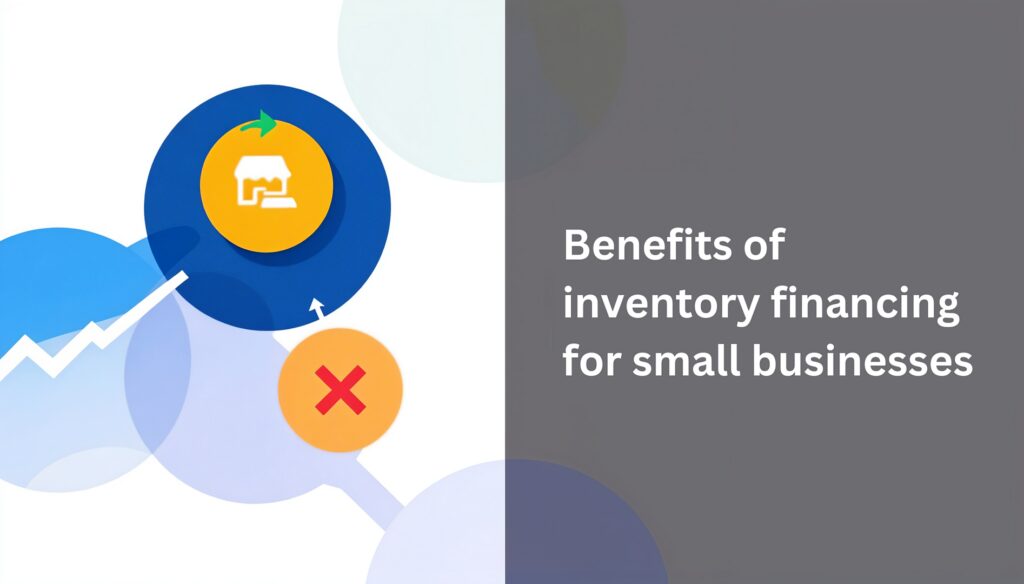Fund Your Company’s Inventory
Inventory financing allows businesses to use inventory as collateral to secure a loan. This can help manage cash flow and ensure you have enough stock for busy seasons. In this article, we’ll explore the top inventory financing options for 2025, how they work, and what you need to qualify for an inventory business loan.
Key Takeaways
- Inventory finance allows small to medium-sized businesses to secure loans using their inventory as collateral, helping them manage cash flow and meet customer demand.
- There are two main types of inventory financing options: term loans, which provide a lump sum with fixed repayment, and lines of credit, offering ongoing access to funds for inventory purchases.
- Challenges include high interest rates, stringent eligibility requirements, and the risk of unsold inventory, making it crucial for businesses to have effective sales forecasting and inventory management.
Understanding Inventory Financing

Inventory financing is a loan that helps small businesses purchase inventory, using the inventory itself as collateral. This type of financing is particularly useful for businesses that face cash flow issues when it’s time to pay for inventory, upon receipt of shipment, or later. Leveraging their inventory allows businesses to secure funding without liquidating other assets or waiting for customer payments. Understanding how inventory financing work can be beneficial for small business owners.
Small to medium-sized businesses, particularly those with limited access to traditional funding options, find inventory financing to be a lifeline for the business owner. It allows these businesses to stock up for busy seasons and pay suppliers before selling products, ensuring they can meet customer demand without delays.
The flexibility and accessibility of inventory financing make it an attractive option for newer businesses looking to grow.
How Inventory Financing Works

Inventory financing allows companies to use their stock as collateral for loans or lines of credit. This means that the inventory intended for sale is pledged to the lender, who assesses its value to determine the loan amount. Lenders often require a thorough inventory audit to verify the accuracy and condition of the stock before approving financing.
The financing amount is typically based on the inventory’s assessed value, considering the type, condition, and current market demand. High-turnover inventory is viewed as more valuable, reducing the risks associated with depreciation. If the loan is not repaid, the lender can claim the unsold inventory as part of their collateral agreement.
Types of Inventory Financing Loans
Inventory financing loans consist of two types. These are term loans and lines of credit. Each type has its own benefits and is suited to different business needs. Retailers, wholesalers, and seasonal businesses can particularly benefit from these loans as they help manage inventory purchases and maintain steady cash flow.
Term Loans
Term loans are conventional bank loans that provide a lump sum upfront with repayment over a set period. These loans involve a fixed amount that must be repaid in regular installments or as a lump sum after selling the inventory. This setup allows businesses to pay for large quantities of inventory upfront, avoiding potential fluctuations in manufacturing costs.
However, term loans may require a personal guarantee or collateral, posing potential risks for borrowers. The fixed repayment structure also means businesses must manage their cash flow carefully to meet repayment schedules, especially during off-peak seasons.
Lines of Credit
A business line of credit allows businesses to draw funds repeatedly up to a pre-established limit. This flexibility helps manage ongoing inventory expenses, making adapting to changing market conditions and sales cycles easier. Payments on lines of credit are also flexible, which can be particularly beneficial for managing seasonal sales fluctuations.
Unlike term loans, lines of credit provide ongoing access to funds, allowing businesses to finance inventory as needed. This can be a significant advantage for companies that experience variable inventory needs throughout the year.
Benefits of Inventory Financing

Inventory financing presents several advantages that can help companies thrive. From improving cash flow to meeting customer demand and avoiding the need for personal collateral, these benefits make inventory financing a valuable tool for many companies.
Improved Cash Flow
Access to inventory financing allows businesses to maintain liquidity during both peak and off-peak seasons. Securing the necessary funds to purchase inventory helps businesses manage seasonal cash flow fluctuations and meet higher inventory demands. This type of financing helps businesses stabilize their cash flow, ensuring they have the resources needed to operate smoothly.
Invoice factoring is another option that can improve cash flow by converting unpaid accounts receivable into immediate cash. This approach allows businesses to receive funding promptly, enhancing financial stability without adding additional debt.
Meeting Customer Demand
Inventory financing provides businesses with quick cash for purchasing inventory, ensuring they can meet customer demands effectively. Maintaining adequate inventory levels enables businesses to drive steady sales and foster growth.
This approach also helps businesses update their product offerings and respond to shifts in customer demand, enhancing customer relationships and satisfaction.
No Personal Assets Required
One of the significant advantages of inventory financing is that businesses can secure funding without relying on their personal credit history or personal assets. Using inventory as collateral enables businesses to avoid risking personal or business assets.
Challenges and Risks of Inventory Financing

While inventory financing offers numerous benefits, it comes with challenges and risks. High interest rates, stringent eligibility requirements, and the risk of unsold inventory can complicate the financing process for businesses.
High Interest Rates
Inventory financing typically incurs higher costs than other types of loans due to its associated risks. Interest rates are higher because of the inherent risks of using inventory as collateral.
Online lenders may offer inventory financing at even higher interest rates than traditional banks, albeit with a faster turnaround.
Stringent Eligibility Requirements
Lenders often require a robust business history and substantial annual revenue to consider inventory financing. Newer businesses may struggle to secure the full funding they need due to their limited operational history. When evaluating applications, Lenders consider resale value, perishability, and market demand.
Risk of Unsold Inventory
If a borrower cannot repay the inventory financing loan, the lender will take away the stock to recover funds. An inventory loan tends to depreciate in value over time, which can further complicate repayment issues for new and struggling companies.
This risk makes it essential for businesses to have a solid sales forecast and inventory management plan.
Eligibility Criteria for Inventory Financing

Lenders evaluate a business’s eligibility based on various factors, including its operational duration, usually requiring at least one year. A detailed sales history report, including turnover and sales projections, is essential for loan applications. Lenders often request detailed reports outlining previous financial performance and inventory turnover for a better assessment.
Additionally, businesses must provide a well-maintained inventory management system that tracks product movement. This inventory system enhances their eligibility for financing, as it demonstrates the ability to manage and sell business assets effectively.
Interestingly, a strong business credit history is not always required, making inventory financing accessible for various businesses.
Steps to Secure Inventory Financing
Securing inventory financing involves several key steps, from preparing financial documents to completing the application and undergoing due diligence.
These steps can help businesses access the necessary funds to finance their inventory needs.
Preparing Financial Documents
Gathering financial documents is a crucial step in the inventory financing application process. Essential documents include balance sheets, profit and loss statements, and an inventory list. Additional documentation for a working capital advance typically includes bank statements, tax returns, and a strategic business plan.
Completing the Application
The application for inventory financing requires submitting basic personal and business information along with financial documents. This step ensures lenders have all the necessary information to assess the business’s creditworthiness and inventory value.
Undergoing Due Diligence
Due diligence refers to the lender’s assessment process to evaluate the borrower’s financial health and the inventory serving as collateral. This process involves detailed inspections and examinations to ensure that the collateral is adequate and secure.
Lenders may require a field audit to assess the inventory’s condition and security as collateral.
Alternatives to Inventory Financing
For businesses seeking other financing options, alternatives such as invoice factoring, merchant cash advances, and purchase order financing provide flexibility in managing cash flow. Each alternative has its benefits and can be a viable option depending on the business’s specific needs.
Invoice Factoring
Invoice factoring allows businesses to convert unpaid invoices into immediate cash by selling them to a factoring company. This process typically involves a factoring company providing an upfront advance of 70-90% of the invoice amount, then collecting full payment from the customer and returning the remaining balance minus a factoring fee.
Businesses can receive funding from Bankers Factoring company promptly through non-recourse invoice factoring, enhancing cash flow without incurring additional debt. PO funding is also offered for re-sold goods to B2B and B2G customers. Invoice factoring from Bankers Factoring is permanent working capital.
Merchant Cash Advances
Merchant cash advances give businesses a lump sum by borrowing against future credit and debit card sales. While this option can be expensive due to high costs, it offers quick access to cash, which can be crucial for managing immediate inventory needs.
Purchase Order Financing
Purchase order financing allows businesses to finance inventory purchases before generating factorable invoices. This option benefits distributors, resellers, and importers who must purchase finished goods before fulfilling orders.
The costs related to purchase order financing can range from 2-4% per 30 days, depending on specific circumstances.
Choosing the Right Inventory Financing Lender
Choosing the right inventory financing lender involves evaluating interest rates and fees to ensure they align with your business’s financial goals. Understanding the repayment terms is essential to align the loan with your cash flow and sales cycles. Researching a lender’s reputation provides insights into their reliability and experience with businesses in your sector.
The speed at which funds are available can be critical for taking advantage of timely inventory purchasing opportunities. Establishing a strong relationship with your lender can lead to better terms and easier access to future financing.
Summary
A form of asset-based lending, inventory financing offers a range of benefits and challenges that businesses must consider carefully. Companies can make informed decisions that support their growth and stability by understanding how inventory financing works, the types of loans available, and the steps to secure funding. Exploring alternatives and choosing the right lender are crucial steps in this journey.
Frequently Asked Questions
What is inventory financing?
Inventory financing is a loan that enables small businesses to purchase inventory, with the inventory serving as collateral. This method provides essential funding while minimizing risk for lenders.
How does inventory financing work?
Inventory financing enables businesses to leverage their inventory as collateral to secure loans or credit lines, with the financing amount determined by the inventory’s assessed value. This approach provides essential liquidity for businesses to manage operations effectively.
What are the types of inventory financing loans?
The two primary types of inventory financing loans are term loans, which provide a lump sum upfront, and lines of credit, which offer flexible, ongoing access to funds. This allows businesses to choose the option that best fits their financial needs.
What are the benefits of inventory financing?
The primary benefits of inventory financing include enhanced cash flow, increased capability to meet customer demand, and the absence of a requirement for personal assets as collateral.
What are the alternatives to inventory financing?
Alternatives to inventory financing include invoice factoring, merchant cash advances, and purchase order financing. Each option provides unique benefits that can support your business’s cash flow needs.
